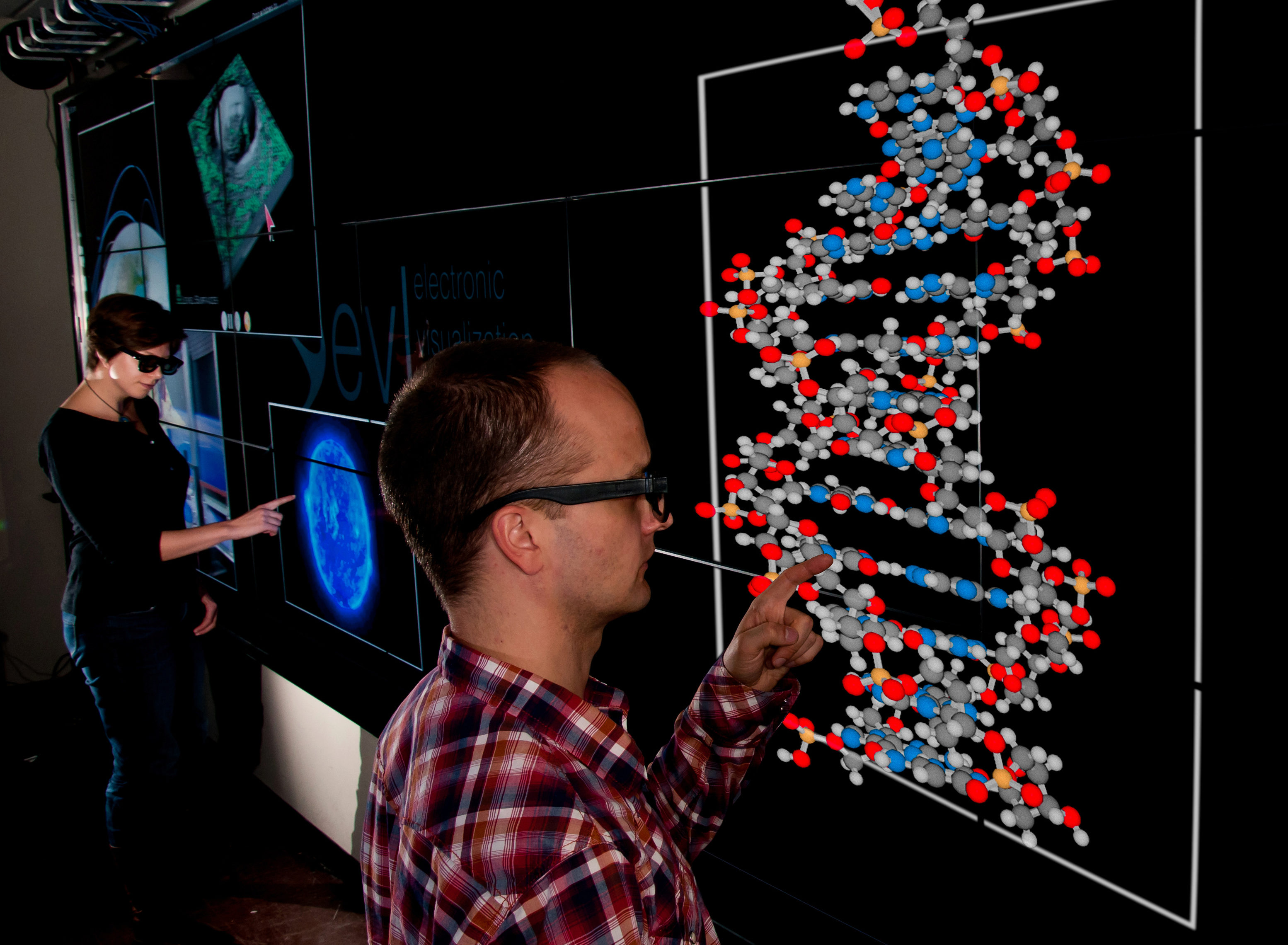New UIC ‘Cyber-Commons’ Wall Pops with 3-D Imagery
November 9th, 2011
Categories: Devices, Multimedia, Software, Tele-Immersion, Visualization, VR

About
by Paul Francuch, UIC NEWS
November 9, 2011
Seamlessly-tiled LCD flat-screen displays stretching floor-to-ceiling and wall-to-wall at the University of Illinois at Chicago’s Electronic Visualization Laboratory “Cyber-Commons” has served as a digitally-enhanced way to display, manipulate and exchange information and images since its opening in 2009. On November 11, EVL demonstrates Cyber-Commons’ latest enhancement - three-dimensional imagery, displayed along with traditional 2-D images.
“It’s a very powerful way to communicate ideas,” said Jason Leigh, UIC-EVL director and professor of computer science. “It lets people work together, make sense of lots of information and hopefully derive insights quicker. We’ve found it changes the way students work together.”
The Cyber-Commons flat-screen displays are tiled on the wall to form a nearly cinematic classroom blackboard that Leigh describes as “democratic” in its use. Anyone in the room with a laptop or tablet device such as an iPad can wirelessly grab space on the Cyber-Commons wall and simultaneously display multiple images from documents to videos. Users can also call up stored images, positioning and sizing them with their fingers on a touch-sensitive display surface. That’s made possible by EVL-developed software called SAGE - Scalable Adaptive Graphics Environment - which also enables Cyber-Commons 3-D, or CC3D, to link via high-performance networks for real-time collaboration with facilities around the world.
“CC3D puts 2-D and 3-D on the same screen at the same time,” said Maxine Brown, EVL’s associate director. CC3D will initially use passive stereo technology to view 3-D. While passive stereo requires special glasses, they’re not expensive like active stereo glasses that cost around $100, now used with consumer 3-D TV sets. “Our glasses cost less than $1,” said Brown, who thinks it’ll be a few years before “auto-stereo” technology - which doesn’t need special glasses - becomes both widespread and cheap. In the meantime, Brown thinks $1 glasses will be widely affordable to schools, museums, medical centers and businesses that are likely to use 3-D Cyber-Commons facilities.
Using 2009 federal economic stimulus grants, EVL worked with Oregon-based Planar Systems to create a 3-D LCD, ultra-thin border flat-panel display wall that gives Cyber-Commons its new, added dimension. After working together on a display prototype, Planar provided EVL with customized technology which they call the “Clarity Matrix LCD Video Wall”. Planar - a company specializing in high quality visualization and digital signage displays - gets a new product to market.
Leigh will test UIC’s CC3D facility next spring when he collaboratively teaches a video game development course with a professor at Louisiana State University. He said UIC-EVL’s focus is on scientific research and educational use, such as medicine, engineering and chemistry, where adding 3-D images which researchers, students and instructors can jointly manipulate and study offers real insight and understanding.
“3-D is more than Hollywood gimmickry,” said Leigh. “Humans understand information much more effectively in 3-D.” Visualizing a molecule, for example, in only two-dimensions can be too abstract or lack the depth cues to be adequately comprehended. Geoscience is another field where 3-D adds substantial advantages. Leigh cited a study of male and female students that found females had typically performed poorer in geospatial tests. But when stereoscopic - 3-D - capability was added to the visualization, both males and females improved and the gender differences disappeared. “It eliminates that barrier,” Leigh said.
CC3D will also serve as a technology test bed for UIC-EVL’s “Next-Generation CAVE” Automatic Virtual Environment facility, debuting a year from now. CAVE, developed 20 years ago at EVL and now commercialized by companies around the world, originally used projectors and very expensive 3-D glasses to work. Leigh calls the new display technology for CC3D bright and “gloriously beautiful.” “We’ll be the first to build an LCD, non-projector-based CAVE,” said Leigh. “We calculate that the display resolution will be on the order of what matches human vision.”
UIC-EVL doctoral graduate Tom Peterka, now a scientist at Argonne National Laboratory, is helping in both NG-CAVE and CC3D development with an eye on possible use of such 3-D technology at America’s national laboratories.